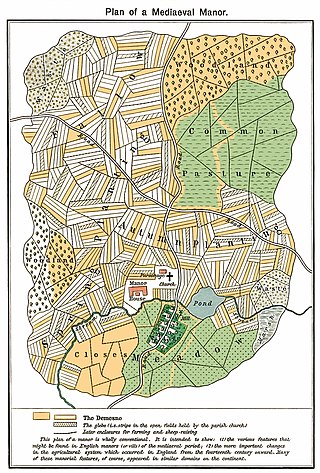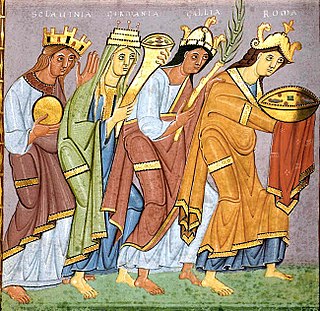
Pan-Slavism, a movement that took shape in the mid-19th century, is the political ideology concerned with promoting integrity and unity for the Slavic people. Its main impact occurred in the Balkans, where non-Slavic empires had ruled the South Slavs for centuries. These were mainly the Byzantine Empire, Austria-Hungary, the Ottoman Empire, and Venice.
The Slavs or Slavic people are groups of people who speak Slavic languages. Slavs are geographically distributed throughout the northern parts of Eurasia; they predominantly inhabit Central Europe, Eastern Europe, and Southeastern Europe, though there is a large Slavic minority scattered across the Baltic states, Northern Asia, and Central Asia, and a substantial Slavic diaspora in the Americas, Western Europe, and Northern Europe.

The Bulgars were Turkic semi-nomadic warrior tribes that flourished in the Pontic–Caspian steppe and the Volga region during the 5th-7th century. They became known as nomadic equestrians in the Volga-Ural region, but some researchers believe that their ethnic roots can be traced to Central Asia.

The open-field system was the prevalent agricultural system in much of Europe during the Middle Ages and lasted into the 20th century in Russia, Iran, and Turkey. Each manor or village had two or three large fields, usually several hundred acres each, which were divided into many narrow strips of land. The strips or selions were cultivated by peasants, often called tenants or serfs. The holdings of a manor also included woodland and pasture areas for common usage and fields belonging to the lord of the manor and the religious authorities, usually Roman Catholics in medieval Western Europe. The farmers customarily lived in separate houses in a nucleated village with a much larger manor house and church nearby. The open-field system necessitated co-operation among the residents of the manor.
Anti-Slavic sentiment, also called Slavophobia, refers to prejudice, collective hatred, and discrimination directed at the various Slavic peoples. Accompanying racism and xenophobia, the most common manifestation of anti-Slavic sentiment throughout history has been the assertion that Slavs are inferior to other peoples. This sentiment peaked during World War II, when Nazi Germany classified Slavs— especially the Poles, Russians, Belarusians and Ukrainians—as "subhumans" and planned to exterminate a large number of them through the Generalplan Ost and Hunger Plan. Slavophobia also emerged twice in the United States: the first time was during the Progressive Era, when immigrants from Eastern Europe were met with opposition from the dominant class of Western European–origin American citizens; and again during the Cold War, when the United States became locked in an intensive global rivalry with the Soviet Union.

The Kindred of the Kibbo Kift was a camping, hiking and handicraft group with ambitions to bring world peace. It was the first of three movements in England associated with the charismatic artist and writer John Hargrave (1894–1982). The Kindred was founded in 1920. Some members continued into Hargrave's Green Shirt Movement for Social Credit, which was established in 1931–32, and which became in 1935 the Social Credit Party of Great Britain and Northern Ireland. This was wound up in 1951.

Adelphopoiesis, or adelphopoiia is a ceremony practiced historically in Orthodox-Christian tradition to unite together two people of the same sex in a church-recognized relationship analogous to siblinghood.

The Finger Lakes National Forest is a United States National Forest that encompasses 16,259 acres (65.80 km2) of Seneca and Schuyler counties, nestled between Seneca Lake and Cayuga Lake in the Finger Lakes Region of the State of New York. It has over 30 miles (50 km) of interconnecting trails that traverse gorges, ravines, pastures, and woodlands.

Danilo I Petrović-Njegoš was the Metropolitan of Cetinje between 1697 and 1735, and the founder of the House of Petrović-Njegoš, which ruled Montenegro from 1697 to 1918.

The Sclaveni or Sklabenoi were early Slavic tribes that raided, invaded and settled in the Balkans in the Early Middle Ages and eventually became one of the progenitors of modern South Slavs. They were mentioned by early Byzantine chroniclers as barbarians having appeared at the Byzantine borders along with the Antes, another Slavic group. The Sclaveni were differentiated from the Antes and Wends ; however, they were described as kin. Eventually, most South Slavic tribes accepted Byzantine or Frankish suzerainty, and came under their cultural influences and Chalcedonian Christianity. The term was widely used as a general catch-all term until the emergence of separate tribal names by the 10th century.

Hoti is a historical Albanian tribe (fis) and sub-region of Malësia, a divided area located in northern Albania and southern Montenegro. Its geography is mostly mountainous, but some of its villages are on flat terrain near the banks of Lake of Shkodër.

Ceklin is a historical tribe (pleme) and region in Montenegro.

Banjani was a tribe of Old Herzegovina, and historical region in western Montenegro. Its territory comprises 380 km2 (150 sq mi), west of Nikšić, in the centre between Nikšić and Bileća, from the top of Njegoš mountain to the Trebišnjica river, and on to the Bileća Lake. All Banjani families have Jovanjdan as their slava.

Boreraig is a deserted township in Strath Swordale on the north shore of Loch Eishort in the parish of Strath, Isle of Skye, Scotland.

The tribes of Montenegro or Montenegrin tribes are historical tribes in the areas of Old Montenegro, Brda, Old Herzegovina and Primorje.
Krvna osveta is a law of vendetta among South Slavic peoples in Montenegro and Herzegovina that has been practiced by Serbs, Bosniaks, and Croats throughout history. First recorded in medieval times, the feud is typically sparked by an offense such as murder, rape, assault, or similar wrongdoing. Associates or relatives of the victim, whether they are genuinely wronged or simply perceive it that way, are then prompted to fulfill the social obligation of avenging the victim. The revenge was seen as a way of maintaining one's honor, which was one of the most important aspects of traditional South Slavic culture.

The early Slavs were Indo-European peoples who lived during the Migration Period and the Early Middle Ages in Central, Eastern and Southeast Europe and established the foundations for the Slavic nations through the Slavic states of the Early and High Middle Ages. The Slavs' original homeland is still a matter of debate due to a lack of historical records; however, scholars believe that it was in Eastern Europe, with Polesia being the most commonly accepted location.

The Shahsevan are a number of Azerbaijani-speaking or Shahsevani dialect Turkic groups that live in northwestern Iran, mainly inhabiting the districts of Mughan, Ardabil, Kharaqan and Khamsa.
The Zanniat tribe are people of western Myanmar (Burma) who are a sub-group of the Chin peoples. The Zanniat tribe has fifty-seven sub-groupings and clans. The group's existence was recorded in Burma's 1931 census after being absent in the Chin Hills gazette of 1896. In 1943, the Zanniat tribal groups of eastern Falam Township were recorded by Henry Stevenson. The Zanniat may also be known by similar sounding names such as Zahnyiet, Zanniet, Zanngiat and Zannaing.













